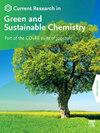印楝和大枣提取物在稳定纳米铜结构中的关键作用:铜纳米结构绿色合成的比较研究
Q2 Materials Science
Current Research in Green and Sustainable Chemistry
Pub Date : 2024-01-01
DOI:10.1016/j.crgsc.2024.100437
引用次数: 0
摘要
纳米铜结构(CuNSs)因其独特的性能而备受关注,例如高抗拉强度、刚度、高表面积、韧性、柔性和延展性。最近,人们不仅越来越关注 CuNSs 的性能,也越来越关注其绿色和可持续生产。本研究强调了一种利用植物提取物合成 CuNSs 的环保方法,为传统方法提供了一种更具可持续性的替代方案。利用大枣和楝树叶提取物进行的绿色合成减少了对有害化学物质的依赖,确保了环境友好性和成本效益。我们利用这种方法将金属盐转化为对环境影响最小的 CuNS。我们利用各种先进的分析技术,如傅立叶变换红外光谱、紫外可见光谱、拉曼光谱、DLS、EDS、XRD、TGA、SEM 和 TEM,对所制备的纳米结构进行了表征。对红枣和楝树基纳米结构的比较表明,红枣中的官能团具有更强的稳定性,使其更适合可持续应用。这项工作强调了绿色技术在生产 CuNSs 方面的潜力,为纳米技术的发展提供了一条具有环保意识的道路。本文章由计算机程序翻译,如有差异,请以英文原文为准。
Critical role of neem and jujube extracts in stabilizing copper nanostructures: A comparative study in green synthesis of CuNSs
Copper nanostructures (CuNSs) have garnered significant attention for their unique properties, such as high tensile strength, stiffness, elevated surface area, toughness, flexibility, and malleability. Recently, there has been a growing focus on not only the performance of CuNSs but also on their green and sustainable production. This study highlights an eco-friendly approach to synthesizing CuNSs using plant extracts, offering a more sustainable alternative to conventional methods. The green synthesis using extracts from jujube and neem leaves reduces the reliance on harmful chemicals, ensuring environmental friendliness and cost-effectiveness. We utilized this method to transform metal salts into CuNSs with minimal environmental impact. The resulting nanostructures were characterized using various advanced analytical techniques, such as FT-IR, UV–Vis, Raman, DLS, EDS, XRD, TGA, SEM, and TEM. The comparison between jujube and neem-based nanostructures demonstrated that the functional groups in jujube offer greater stabilization, making them more suitable for sustainable applications. This work emphasizes the potential of green techniques in producing CuNSs, offering an environmentally conscious path forward in nanotechnology.
求助全文
通过发布文献求助,成功后即可免费获取论文全文。
去求助
来源期刊

Current Research in Green and Sustainable Chemistry
Materials Science-Materials Chemistry
CiteScore
11.20
自引率
0.00%
发文量
116
审稿时长
78 days
 求助内容:
求助内容: 应助结果提醒方式:
应助结果提醒方式:


